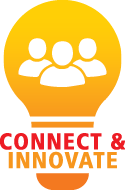3 Ways to Connect & Innovate
Stay ahead of the curve with these easy tips for becoming an innovative educator.

Communicator
August 2016, Volume 39, Issue 12
Principals must constantly innovate, challenging the education communities they lead to raise the bar, as well as to shift direction to respond to new initiatives and technologies. In Principal magazine’s four-part series, Connect & Innovate, experts and educators offer strategies principals can use to be more innovative in their leadership. Here are three ways you can connect with fellow educators, and try new ideas at your school.
Free tools are your friend
When searching for digital educational tools, it’s easy to get discouraged while sifting through costly programs. In “Fill Up Your Digital Toolbox,” author Deborah B. Ford shows how to make the most of free online tools for blended learning. She highlights some of the best free resources that can enhance your school’s blended learning experience:
- Newsela rewrites current events on a daily basis and combines them with an assessment that is just right for every student.
- ReadWorks.org offers leveled fictional and informational texts with assessments similar to those of the Common Core State Standards.
- Wonderopolis provides free informational texts.
Learn from others
Principals can learn a lot from fellow school leaders when it comes to implementing innovative ideas. In fact, in “Crack the Code,” several provided examples of coding projects at their school, and volunteered more details to anyone who finds them on twitter. Tennessee principal Kimbrelle B. Lewis (@k2blewis) highlighted a coding game her school’s computer developed:
Partners work together to write code, sequence directions, and conditional loops and statements to maneuver around a life-size game board. Students then use the Tynker visual programming platform to apply those ideas.
In addition to connecting to other school leaders, Ben Gilpin and Brad Gustafson argue in “Leadership for Tomorrow,” that it’s important that principals “embrace a mindset of innovation to stay current with pedagogical shifts and best practices.” Here are just a few examples of ways to innovate at your school:
- Convert your paper or e-mailed newsletters to podcasts;
- Increase parent engagement by live-streaming concerts and special events via Periscope;
- Install flat-screen TV monitors to display classroom learning tweets in school hallways;
- Start a blog (check out the “Colorful Principal” or “Adjusting Course” blogs for ideas);
- Amplify student voice by starting a cafeteria DJ program with students; or
- Make the EdCamp model part of your school’s approach to professional development.
Keep the focus on people
The prospect of introducing new technology can be exciting, but it’s important to remember that technology should serve a purpose for people at your school. In “Shifting the Focus to People,” Vincent Cho, Ann Allwarden, and Jeffrey C. Wayman argue that too often data systems are put in place without adequate discussion and planning with the people who will be using it. They offer a few guiding questions to answer before using new data systems:
- What is our vision for teaching and learning?
- What is our vision for how data support teaching and learning?
- How might we use the data system to support our vision?
- To what extent do we actually use the data system?
- What knowledge and skills do we need to use the data system effectively?
- How will we view mistakes and failure?
It’s worth reviewing these questions and others in more detail when considering implementing new data systems. Additionally, these types of questions can apply whenever introducing a new tool or technology for school improvement.
—
Copyright © 2016. National Association of Elementary School Principals. No part of the articles in NAESP magazines, newsletters, or website may be reproduced in any medium without the permission of the National Association of Elementary School Principals. For more information, view NAESP’s reprint policy.


